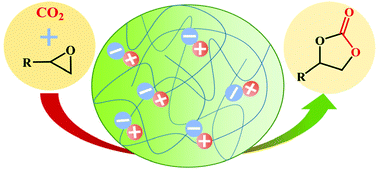Synthesis of porous poly(ionic liquid)s for chemical CO2 fixation with epoxides
Abstract
Chemical carbon dioxide (CO2) fixation via cycloaddition with high energy three-membered ring compounds such as epoxides is among the most promising pathways to reduce the greenhouse gas emission and achieve the utilization of CO2 as an abundant C1 resource, favoring the alleviation of the global energy and environmental issues. A great number of catalysts have been developed, while heterogeneous ones are preferred due to the facile product separation and catalyst recycling. Among them, porous poly(ionic liquid)s (PILs) combining the advantages of porous materials, polymers and ionic liquids (ILs; for simplification, in this review, ILs comprise these traditional room temperature ILs and their derivatives) have exhibited great potential in CO2 fixation via cycloaddition. This review systematically summarizes the recent progress in the one-pot synthesis and post-synthesis of porous PIL catalysts for CO2 cycloadditions. The former covers the free-radical homopolymerization of ILs, free radical co-polymerization of ILs and linkers, quaternization reaction, Friedel–Crafts alkylation reaction, and several polycondensations via Schiff base chemistry, phenol–formaldehyde condensation reaction, click reaction, Heck and Zincke reaction, Sonogashira coupling reaction, trimerization reaction, and urea-forming condensation reaction. Post-synthesis of porous PILs mainly relies on the immobilization of ILs on a porous polymer support. One-pot synthesis is advantageous in the molecular level design and construction of porous PILs with large surface areas and high density of ionic moieties with homogeneous distribution, providing highly effective catalysts for CO2 cycloaddition under mild conditions. The details of the synthesis of porous PILs and the catalytic behavior in CO2 cycloaddition with epoxides are summarized, and it is emphasized that the rational design of IL monomers and optimization of synthetic parameters to control the structural characteristics and chemical compositions of porous PILs are crucial to the fabrication of high-performance catalysts. Finally, we pointed out that great efforts are still needed towards advanced porous PILs for CO2 cycloaddition to increase the activity, stability and scope. Besides, the cost of porous PILs should be lowered to adapt to industrial applications.

- This article is part of the themed collections: Green Chemistry Reviews and 2022 Green Chemistry Hot Articles


 Please wait while we load your content...
Please wait while we load your content...